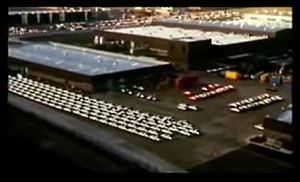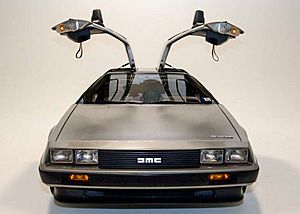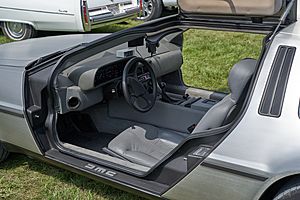DeLorean Motor Company facts for kids
 |
|
| Industry | Automotive |
|---|---|
| Founded | October 24, 1975 |
| Founder | John DeLorean |
| Defunct | October 26, 1982 |
| Headquarters |
,
U.S.
|
| Products | DMC DeLorean |
The DeLorean Motor Company (DMC) was an American car maker. It was started by a car expert named John DeLorean in 1975. The company is famous for the one car it made: the DMC DeLorean. This sports car had a cool stainless steel body and special gull-wing doors that opened upwards.
DMC had a short and difficult history. It went out of business in 1982. Even so, the DeLorean car became very well known. It was used as a time machine in the popular Back to the Future movies. The company had already closed down before the first movie came out in 1985.
In 1995, a mechanic named Stephen Wynne started a new company. It is also called the DeLorean Motor Company (Texas). This new company is not connected to the original one. It bought the remaining car parts and uses a similar "DMC" logo.
Contents
History of DeLorean Motor Company
How it Started
John DeLorean began the DeLorean Motor Company in Detroit, Michigan, on October 24, 1975. He was already a well-known person in the car world. He was a smart engineer and a top executive at General Motors.
Money for the company came from different places. Bank of America gave loans. Famous people like TV host Johnny Carson and entertainers Roy Clark and Sammy Davis Jr. also invested their own money. Car dealerships that wanted to sell DeLorean cars also became part-owners of the company.
John DeLorean also looked for help from governments. He wanted to build his factory in a place where many people needed jobs. He almost made a deal in Puerto Rico. But then, he got a better offer from the government in Northern Ireland. The British government wanted to create jobs there. They gave DeLorean's company about $120 million to help it start.
Building the Factory

In October 1978, work began on the DeLorean factory in Northern Ireland. It was a large building, about 660,000 square feet. The factory was built in just 16 months. It also had a special track nearby for testing cars. The factory was officially called DMCL (DeLorean Motor Cars, Ltd.). It was located in Dunmurry, a town near Belfast.
Car production was supposed to start in 1979. However, there were delays in engineering and costs went over budget. So, the factory only began making cars in early 1981. Many workers at the factory were new to car building. Some had never had a job before. This led to some problems with the quality of the first cars.
To fix this, special Quality Assurance Centers (QAC) were set up. These centers were in places like California and New Jersey. Here, some car problems were fixed before they went to dealerships. Issues included how body panels fit and adjusting the gull-wing doors. By 1982, the quality of the cars got much better. This was thanks to improved parts and more experienced workers.
Company Problems and Closing Down
By late 1981, DMC started having money problems. This was because not enough cars were being sold. Also, the costs of making cars were too high. The company needed to sell between 10,000 and 12,000 cars to make a profit. But they only sold about 6,000.
The company tried to get more money, but it didn't work. In 1982, DMC went out of business. This meant 2,500 people lost their jobs. Over $100 million that had been invested was also lost. The British government tried to save parts of the factory, but they couldn't. The factory in Dunmurry closed down.
About 9,000 DeLorean cars were made between January 1981 and December 1982. Some cars made in 1982 were not sent to the U.S. because the American part of DMC ran out of money. These cars were later sold by another company.
Years later, in 1989, a French company called Montupet took over the old DeLorean factory. They started making car parts there. Today, the factory is still used for making car parts.
DeLorean Vehicles
The DeLorean Car
The DeLorean (also called the DMC-12 during its design) was the only car DMC ever made. People had mixed feelings about it. Many people wanted to buy the car at first. But its price of $25,000 (which would be about $70,000 today) was very high. Some thought it was not fast enough for a sports car. It took 10.5 seconds to go from 0 to 60 miles per hour.
The car's stainless steel body looked cool and would not rust. But it easily showed fingerprints. Also, it was hard to paint, so most DeLoreans looked the same. Some dealerships painted cars to make them different. The only factory option was an automatic transmission. Later, a grey interior was offered.
The DeLorean became very famous after it was used as a time machine in the 1985 movie Back to the Future and its sequels. This made the car a pop culture icon.
Future Car Ideas (Concepts)
DMC also had ideas for other cars that were never built. These were called "concept" cars.
DMC-24
The DMC-24 was an idea for a 4-seater sedan car. It would have kept the DeLorean's shape and gull-wing doors. Some designs showed a longer DeLorean with back seats. Another design had separate back doors. A model of a 4-door car was even built, but DMC did not pay for it.
DMC-44
The DMC-44 was an idea for a light 4x4 off-road vehicle. It would have used parts from a small Polish car. The design was like a French army vehicle. A test model was made, and a video was created to get people to invest in the project. There would have been two versions: one for off-road use and one for regular roads.
DMC-80
In 1981, DMC also thought about making a bus called the DMC-80. They even made a brochure to show to public transport companies. This bus would have been an American version of a German low-floor bus.
|
See also
 In Spanish: DeLorean Motor Company para niños
In Spanish: DeLorean Motor Company para niños




